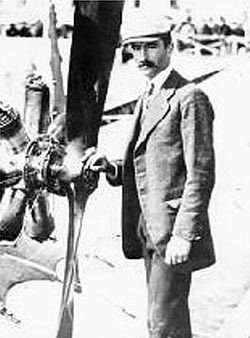
Henri Fabre (1882-1984)The first seaplane (Hydravion) was built and flown by Henri Fabre in 1910 at Martigues, France. It used a 50 horsepower Gnome rotary engine, Fabre flew some 1-1/4 miles at a height of approximately 6-1/2 feet1650 feet on water (March 28, 1910)
Les origines de l'hydravion C'est en 1910 que l'on vit apparaître « l'hydro-aéroplane ». Le 28 mars, l'ingénieur marseillais Henri Fabre réussissait sur l'étang de Berre quatre vols consécutifs, dont un de 600 mètres.
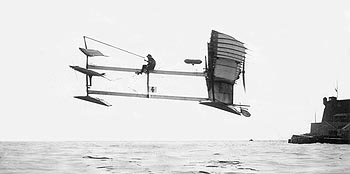 Henri Fabre, Hydravion, March 28, 1910 Download a 1000pixel image
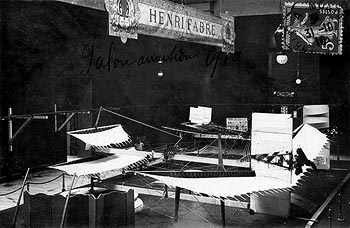 Henri Fabre's Hydravion at the 'Salon Aviation', 1910 Download a 1000pixel image
Monaco, April 1911
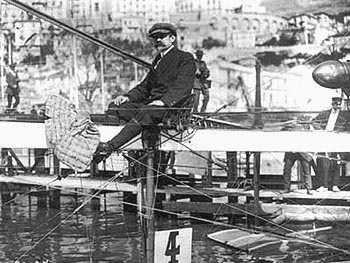 Henri Fabre's Hydravion La photo a été prise à Monaco en avril 1911, le pilote est Jean Bécu
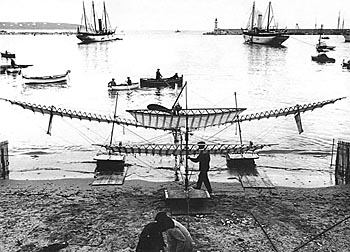 Henri Fabre's Hydravion La photo a été prise à Monaco en avril, 1911, le pilote est Jean Bécue Download a 1000pixel or 1500pixel image
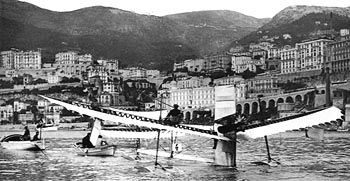 Henri Fabre's Hydravion La photo a été prise à Monaco en avril 1911, le pilote est Jean Bécue Download a 1000pixel or 1500pixel image
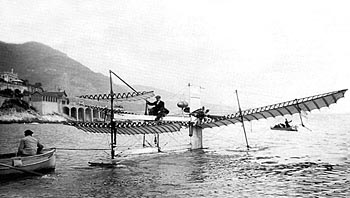 Henri Fabre's Hydravion La photo a été prise à Monaco en avril 1911, le pilote est Jean Bécue Download a 1000pixel or 1500pixel image
Le lendemain, Fabre parcourait six kilomètres au-dessus de l'eau, décollant et amerrissant facilement. Gabriel Voisin construisait ensuite un appareil amphibie, expérimenté par Colliex; il s'agissait d'un hydro-aéroplane du type « canard » qui réussit quelques beaux vols, partant de la Seine et revenant s'y poser, après un atterrissage sur le terrain d'Issy-les-Moulineaux.
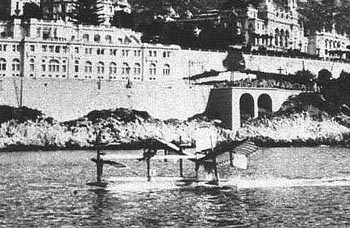 Henri Fabre's Hydravion La photo a été prise à Monaco en avril 1911, le pilote est Jean Bécue
C'est de 1912 que datent les premiers hydravions à coque, construits en France par Denhaut. L'idée en était reprise par Curtiss aux Etats-Unis. La même année eut lieu à Monaco un grand meeting, première manifestation collective de l'hydravion, et qui se trouve à l'origine de la coupe Schneider.
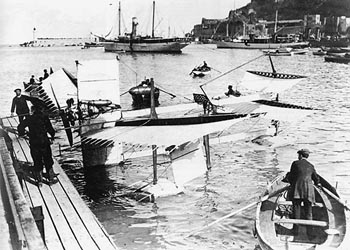 Henri Fabre's Hydravion La photo a été prise à Monaco en avril 1911, le pilote est Jean Bécue Download a 1000pixel image
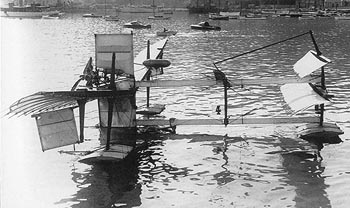 Henri Fabre's Hydravion La photo a été prise à Monaco en avril 1911, le pilote est Jean Bécue Download a 1000pixel image
Cette dernière, âprement disputée durant de longues années, devait permettre,après le premier conflit mondial, d'établir d'étonnants records de vitesse pure.
A History of Flight, Airlines and Airmails On March 28, 1910 a Frenchman by the name of Henri Fabre made the first powered takeoff from water at La Mëde harbor, near Marseilles. Fabre named his seaplane Hydravion. It looked extremely fragile, and when Fabre made this flight it was the first time he had ever piloted an aircraft. The actual flight covered about a mile and a half at just a few feet above the water. The Hydravion was powered by a 50 horsepower Gnome 7-cylinder rotary engine. The length of the aircraft was 27 feet 10 inches and the wingspan was 45 feet 11 inches. The frame was constructed of ash with cotton covering, and the floats were made from plywood. Total weight of the Hydravion was 1,047 pounds and the cruising speed was 55 miles per hour. Fabre had not been the first to attempt a takeoff with a seaplane. An Austrian by the name of William Kress had built his own aircraft and tested it on Lake Tullnerbach, near Vienna, as early as October of 1901. The seaplane floated for a while but was not able to achieve takeoff. While making a turn, it capsized and sank. Kress, who was close to 70 years old, did not repeat the experiment. Gabriel Voisin and Ernest Archdeacon built a glider that was designed to takeoff from water. They tested it twice, in June and July of 1905, on the Seine River between the towns of Sëvres and Billancourt. The glider was pulled by a steamboat and on both occasions the airplane managed to rise above the water and fly for a few hundred feet. Louis Blèriot had begun his career as an airman with a seaplane in the same year. Blèriot purchased a variant of the Voisin-Archdeacon glider (this particular aircraft became known as the Blèriot-Voisin) and came close to drowning when he tested it for the first time. Bleriot then designed his own seaplane-glider, the Bleriot III, which he tested on Lake Enghien in May of 1906. The test was not a success. In America, Glenn Hammond Curtiss began testing a seaplane in 1908, but it took until January 26, 1911, at San Diego, before the first Curtiss seaplane could takeoff from the water. That aircraft, known as the D Hydro, had a central float and two stabilizers under the wingtips. Three weeks later, on February 17, the Curtiss D-III Tractor Hydro (picture below) made a demonstration flight from North Island naval base in San Diego to the cruiser U.S.S. Pennsylvania, which was anchored in San Diego harbor. That flight convinced the Navy to buy two seaplanes, designated A-1 and A-2. The first two U.S. Navy pilots were both Lieutenants -- Theodore G. Ellyson and John H. Towers. These two made numerous test flights, the majority of which were concerned with perfection of launching techniques. Various systems and ideas were tried to this end, including catapulting the aircraft with a compressed air launcher that had been developed for torpedos.
Henri Fabre authentique pionnier Ces jours derniers, bien des habitués de l'aérogare de Marignane devaient regarder avec émotion le premier hydravion du monde, restauré par une équipe d'enthousiastes de l'Aerospatiale. Ils ne pouvaient ignorer qu'Henri Fabre s'était éteint le 29 juin dans sa 102e année. Né le 29 novembre 1882, il était le dernier de cette phalange d'authentiques pionniers qui, en France, comme Ader, Santos-Dumont, Voisin, Blériot, Breguet et Esnault-Pelterie... et quelques autres... avaient été les vrais précurseurs, les vrais initiateurs de l'aviation. Henri Fabre dès 1909 avait conçu, étudié et construit un hydravion aux formes étranges. Sur l'étang de Berre le 28 mars 1910 il était le premier à décoller de l'eau. Son éducation au collège des jésuites de Marseille, ses études scientifiques très poussées, ses travaux préparatoires méthodiques sur les flotteurs et sur les hélices, ne pouvaient qu'amener Henri Fabre au succès. Père de l'hydravion, il n'hésita pas à faire bénéficier de son expérience Glenn Curtiss qui se lança à son tour sur les appareils à flotteurs. Gabriel Voisin devait, à son tour, utiliser la technique Fabre. Mais on doit aussi à ce précurseur d'avoir vu naître les premiers hydravions de notre marinepuisque pendant la première guerre il créa une société employant 200 personnes pour produire en série des hydravions. Aujourd'hui disparaît un " grand Père" de l'aviation. Des personnages de cette ampleur ne peuvent être oubliés. Aux " Vieilles Tiges », comme à l'Aéroclub de France et au Musée de l'Air, bien souvent, il fut honoré ces dernières années, c'est dire que son absence sera ressentie profondément.
Texte et croquis J. NOETINGER.
|
© Copyright 1999-2002 CTIE - All Rights Reserved - Caution |
